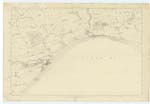OS1/13/97/8
| List of names as written | Various modes of spelling | Authorities for spelling | Situation | Description remarks |
|---|---|---|---|---|
| MONUMENTAL STONE [Largo House] | Standing Stone Standing Stone Standing Stone |
Mr White Mr Smeal His. [History] of Fife Leightons |
025 | [situation] In front of Largo House. An ancient standing stone situated on the lawn in front of Largo House. It is about six feet high and about three feet in breadth, and is covered with grotesque ornamental carving. On the one side is a cross distinctly visible. A part of this ancient and curious object was found on the estate of Largo several years ago by the then proprietor. The remaining portion was discovered about the year 1839 and the pieces having been joined; it was placed placed in its present position by the late General Durham_Of its origin nothing is known_ opposite is a sketch representing one side By Captain Lewis R.E.[Royal Engineer] |
Continued entries/extra info
Parish of Largo [Page] 8"Monumental Stone" to be written on Plan by order of Captain [---] R.E. [Royal Engineer]. This stone does not appear to be of that rare descriptions represented in Stat. Acct. [Statistical Account] and other writing as it resembled in a large many of the Sepulchoral monuments seen in some old Grave yards in Ireland.
In the lawn in front of Largo House is one of those carved stones called Runie. A considerable number of years ago one half of this stone was found on the estate of Largo: and at a subsequent period, the other half was found at a place more than a mile distant. Being found to be a part of the same ancient relique, they were built into a wall in order to preserve them; but General Durham had the two pieces removed and erected on a pedestal, in their present situations on the lawn. This singular monument presents on the one side a maltese cross, something like that on the cross at Crail; the upper part of the stone presenting a circle, [---] of a part of Crail Cross, and one of the side slabs of the St Andrews sarcophagus. On the right side of the body of the Cross, below the [---] are two fishes or serpents intertwined, having heads like horses: and on the left, something like a figure sitting having an elephants head, of which the trunk is apparent. The body of this cross been ornamented with a variety of carving, some of which would appear to have been serpents intertwined. The reverse side of this monument represents the usual hunting Oclus which this Class of [---] almost invariably represents."
(Fullarton's Gazetteer of Scotland, Vol [Volume] 2 p. [page] 224)
Transcriber's notes
There are many entries on this page in different coloured inks and hands. I have tried to transcribe as carefully as I can.Transcribers who have contributed to this page.
Lorraine
Location information for this page.
Linked mapsheets.




